Last Updated on October 23, 2023
Americans spend over 400 hours in the kitchen each year. I probably spend more time than that in my kitchen because I’m frequently experimenting with recipes and filming for my scraptastic recipe series.
The problem is many of the kitchen products, utensils and containers we use daily are made from plastic.

Only 5-6% of plastic gets recycled, while the rest ends up in landfills or the environment.
To make plastic, crude oil must be extracted unsustainably from the earth where it goes to a fossil fuel powered factory that transforms it into a useable material, aka plastic. Then, more emissions are produced to transport it around the world.
Plastic has a high carbon footprint, but it also has potentially adverse health effects. Plastic can leach harmful chemicals into your food, especially if you’re heating it up in the microwave.
Heat helps to break the chemical bonds in plastic, so it’s possible that exposure to high temperatures (like when we put plastic in microwaves) increases the rate of chemical migration from the container into the food. Scientists have documented higher rates of chemical migration even in water bottles left in the sun.
The best bet is to avoid over-utilizing plastic in our kitchens (especially single-use). But beyond reducing plastic, there are many ways we can create a healthier kitchen environment. Here’s how to create a non-toxic kitchen that’s also low waste.
what is the least toxic cookware?
The least toxic cookware for your health is non-Teflon coated options. Materials like cast iron, stainless steel, or ceramic are the best options because they can withstand high temperatures and don’t leach toxins into your food.
Teflon coating contains PFAS chemicals (aka Per- and polyfluoroalkyl substances) which are linked with negative health concerns, including infertility and cancer.
PFAS have been nicknamed “forever chemicals” because they don’t break down in the environment, or in our bodies. Instead, they build up year after year.
For my favorite Teflon-free brands, be sure to check out these non-toxic cookware and bakeware options.
are bamboo cooking utensils non-toxic?
Yes, bamboo cooking utensils are non-toxic, if the bamboo is grown from a trusted source. Bamboo is a natural and renewable material: It grows very fast in comparison to trees.
However, sometimes manufacturers of bamboo can process it with harmful chemicals or solvents. You’ll want to look for brands that use 100% bamboo and don’t use any glues or lacquers.
The European Commission recently published an article about the false claims of food materials and products labeled eco-friendly that use potentially harmful additives. Many brands will mix “bamboo powder” into plastic.
Bambu is a good brand to look into, as they openly state they use no glues or lacquers and their products are made from 100% bamboo, making them completely compostable.

how do I make my kitchen non toxic?
Having a non-toxic kitchen basically means making more informed decisions that promote a healthy lifestyle. This also trickles into a sustainable lifestyle, because usually wellness of self = wellness of planet.
RELATED: 10 Wellness Habits For Living Healthy
What’s good for you tends to also be good for the earth, and vice versa.
For example, eating fresh whole foods from small local farmers promotes a healthy diet, and doesn’t contribute to monocultures. Monoculture is the practice of growing one crop species in a field at a time, which depletes the soil of vital nutrients and decreases biodiversity.
In contrast, polyculture, which small farmers are more likely to embrace, attempts to mimic the diversity of natural ecosystems by planting multiple crops that give back to the soil.
This is just one example of ways creating a non-toxic kitchen is good for you and the planet. Here are 10 other ways you can have a non-toxic kitchen.
1. swap out your teflon-coated cookware
As mentioned earlier, non-stick cookware and bakeware is also often coated in Teflon.
Teflon is made with a specific kind of Perfluorocarbon (PFC) that makes the surface of cookware resistant to sticking.
The problem with this is when Teflon coated pans get overheated (above 500 degrees F), the Teflon coatings on nonstick cookware start to break down, releasing toxic chemicals into the air.
It only takes 2.5 minutes for a traditional non-stick pan on high heat to exceed 500 degrees F and begin releasing forever chemicals. And FYI, the chemicals in Teflon can easily kill pet birds when cookware overheats.
Here are some non-toxic cookware and bakeware options you can replace them with.

2. choose better food storage
There’s a lack of transparency about the chemical make-up of plastic food containers. Plastic is not a completely stable material, and due to this, it does not mix well with heat.
When exposed to heat in the dishwasher or microwave, polyethylene and polypropylene (both used to make food storage containers) can break down, leaching unknown chemicals into food and drink. Oily foods are also thought to attract some plastic chemicals.
With this in mind, switching to glass snapware, glass jars and silicone bags is the safer option.
You can store and freeze food without plastic: Just make sure if you’re using a mason jar to leave some room at the top before freezing liquids (at least an inch). This will reduce the chance of the mason jar cracking in the freezer.
RELATED: Food Safe Storage Containers and More: 8 Ways to Store Food Without Plastic
3. avoid plastic film wrap
Plastic film wrap cannot be recycled with curbside recycling. To recycle it you need to have access to a specific take-back program, like one of Terracycle’s zero waste boxes. Otherwise, it’s destined for landfill.
Opt for Beeswrap instead. Beeswrap is made from cloth and beeswax, so it’s fully compostable at the end of its life. Or, place leftovers in a bowl and cover it with a plate.
4. filter your water
PFAS were recently found in tap water. Plus, other hazards like lead, heavy metals, chlorine and even herbicides can be detected in some tap water.
This doesn’t mean you should drink from bottled water: The plastic bottles are single-use plastic and can leach chemicals into the water. Instead, investing in a good water filtration system is important.
I recommend activated charcoal filters. Activated charcoal naturally bonds with toxins. The sticks remove mercury, chlorine, copper, and even lead.
You can also invest in a Berkey or a Soma, which are sustainable water filters I’ve tried myself.
The Berkey water filter is made from stainless steel and sits on your countertop. You use it kind of similar to a water dispenser.
The Soma can be bought as a pitcher, or a carafe. The pitcher is designed using BPA-free plastic and an eco-friendly bamboo handle. The carafe is made from shatter-resistant, borosilicate glass and holds 6-cups (48 oz.) of filtered water.

5. choose organic, locally grown, plastic-free produce
When possible, hit up your local farmers market: It’s easier to shop there plastic-free, plus you get to see what’s in season.
You can ask the farmers directly about their farming practices. They’ll likely avoid using pesticides and herbicides, but you can double check with them, which you can’t easily do at a grocery store.
You may even have a local farm you can visit near you. Take a trip to see their practices in person and learn more about where your food comes from.
These are my favorite market essentials: Be sure to take several reusable produce bags and tote bags with you!
6. grow your own herbs
Most herbs sold in stores come in little tiny plastic containers. Skip the packaging and grow your own.
Herbs are easy to grow on kitchen windowsills. It’s also a great way to know exactly where your food is coming from, and make sure it’s grown organically.
You can just snip off however much you need for each recipe and watch the herb continue to grow. Basil, rosemary, thyme, mint and chives all grow especially well on a windowsill.

7. clean using eco-friendly products
Most of the conventional cleaning products sold in stores contain questionable ingredients and single-use packaging. In the US, cleaning companies aren’t legally required to disclose the ingredients in their products.
This is a big issue, considering conventional cleaning products can emit volatile organic compounds (vocs the building blocks of smog) which can trigger asthma and allergy symptoms.
Instead, choose all-natural cleaning DIYs, or trusted eco-friendly cleaning products sold on the market. Here are my favorite sustainable cleaning products that actually get the job done without harsh chemicals.
Prefer DIY solutions? Baking soda is a simple, but abrasive ingredient that can be used to clean the sink and oven. You can also use it to get tough stuck-on stains off pots and pans.
For a non-toxic kitchen cleaner that can be used on any surface, try making my all-purpose cleaner.
8. avoid plastic cutting boards
According to a recent study, chopping produce on a plastic cutting board leads to substantial microplastics in human food. It’s estimated to have an annual exposure of 7.4-50.7 grams of microplastics from a polyethylene chopping board and 49.5 grams of microplastics from a polypropylene chopping board.
While the effects of ingesting microplastics on human health are unknown, it cannot be good. Microplastics have been found in our blood, feces, lungs, and even our placentas.
Opting for a wooden cutting board is a better option. Ones made from solid wood with no glues and resins are best. Maple, walnut, cherry, beech, or teak wood are good options.

9. swap out plastic sponges
Kitchen sponges harbor more bacteria than kitchen brushes, which may be a more hygienic way to clean your dishes, according to a new study published online in the Journal of Applied Microbiology.
Plastic sponges also need to be replaced often, and they are not recyclable. An estimated 400 million plastic sponges are discarded annually in the United States alone.
Try a wooden dish brush instead to create a more low waste, non-toxic kitchen. The head can be removed and replaced as needed, plus it’s compostable so there’s no waste.
10. consider getting an induction stove
Gas stoves can cause indoor nitrogen dioxide levels to spike quickly, reaching hazardous levels in the amount of time it takes to bake a cake.
This is especially harmful to children who live in a home with a gas stove, as the increased risk of developing asthma is on par with living in a home with a smoker.
Cooking with gas has also been shown to be harmful to the environment, emitting greenhouse gases into the atmosphere. A recent study found that 75 percent of oven emissions occur when the stove is off. In other words, gas stoves old and new are constantly emitting methane.
Induction cooktops instead use electromagnets to efficiently heat cookware without the pollution or toxic fumes. Here’s more information on why I ditched gas and got an induction cooktop instead (and why you should too).
What are your tips for creating a more non-toxic kitchen? Let me know in the comments below.
The post 10 Ways to Create a Non-Toxic Kitchen appeared first on Going Zero Waste.
Green Living
How Toad&Co’s Clothes Help Everyone Enjoy the Outdoors
This is a sponsored article about a brand that was independently assessed by our rigorous ratings system. We’re proud to only collaborate with “Good” and “Great” rated brands. Learn more.
US brand Toad&Co has a socially and environmentally responsible approach to clothing, creating pieces inspired by the outdoors and with a lower impact on the environment. Not to mention an enduring commitment to helping everyone get outdoors through its work with non-profits. Read on to discover the brand’s environment-first ethos.
Focusing on what matters most
“We make feel-good clothes for positive impact—fostering community around doing good, enjoying life’s simple pleasures, and embracing the unexpected,” says Sarah Palladino, director of people and impact at Toad&Co as she introduces the Californian brand. This “simple pleasures” concept applies to Toad&Co’s approach to design, too, and prioritises quality and responsibility over trend-led items. This, in turn, means the brand focuses its energy on clothes that are comfy and practical enough for everything from work to outdoor exploring, and on maintaining its ongoing commitments to using lower-impact materials, partnering with cleaner factories, and looking for new ways to do more with less.
Since day one, it’s been about more than just clothes. From choosing sustainable practices in every corner of our business to supporting programs that protect the planet and make the outdoors more accessible to everyone—knowing we stand for more is what keeps us going
Gordon Seabury – CEO at Toad&Co
Lower-impact materials and producer responsibility
Opting for lower impact materials is one of the core ways brands can address their impact on the planet: “Sustainable materials make a world of difference,” Toad&Co says. “We use organic cotton, recycled fibres, and other high-quality materials known for low-impact growing and cleaner manufacturing.”
The brand’s selection of more sustainable materials includes organic cotton, hemp, TENCEL Lyocell, and recycled fabrics like wool, cotton, and polyester. It also looks to third party clothing certifications like bluesign®, OEKO-TEX® STANDARD 100, and Global Organic Textile Standard, and it publishes its list of restricted substances for all to see.
Toad&Co also operates a resale platform, called ToadAgain, online and at its IRL store in Maine, US, to keep its clothes in the loop.
Supporting non-profits and access to the outdoors
Toad&Co donates 1% of its profits to organisations working to empower others and, in particular, enable better access to the outdoors for all.
In 1996, Toad&Co partnered with Search, Inc. to co-found the Planet Access Company, a full-functioning warehouse that trained and employed up to 70 adults with disabilities annually.
Determined not to stop at the front door, the brand also co-founded Search for Adventure in 2004, a unique travel program to facilitate vacations for adults with disabilities. Over 20 years later, the social venture partnership has evolved—and includes a flagship store in Chicago, a program called Visibility Arts that nurtures creativity through sharing Search, Inc. artist’s work, neurodiversity and disability awareness training, and an expanded Search for Adventure program. In 2024, the brand supported 147 nights of camping for adults with disabilities through the program.
We give back to—and partner with—organisations that align with our three pillars of giving: conservation for human enjoyment, equity and accessibility, and do the right thing
Sarah Palladino – director of people and impact at Toad&Co
One of Toad&Co’s key partnerships is with Brave Trails, which is dedicated to LGBTQ+ youth leadership, to support it in putting on accredited camps, mentorship programs, and meet-ups for LGBTQ+ youth.
Shop favourites from Toad&Co’s new collection
Read on to discover some of the standout items that balance style with practicality from Toad&Co’s lineup.
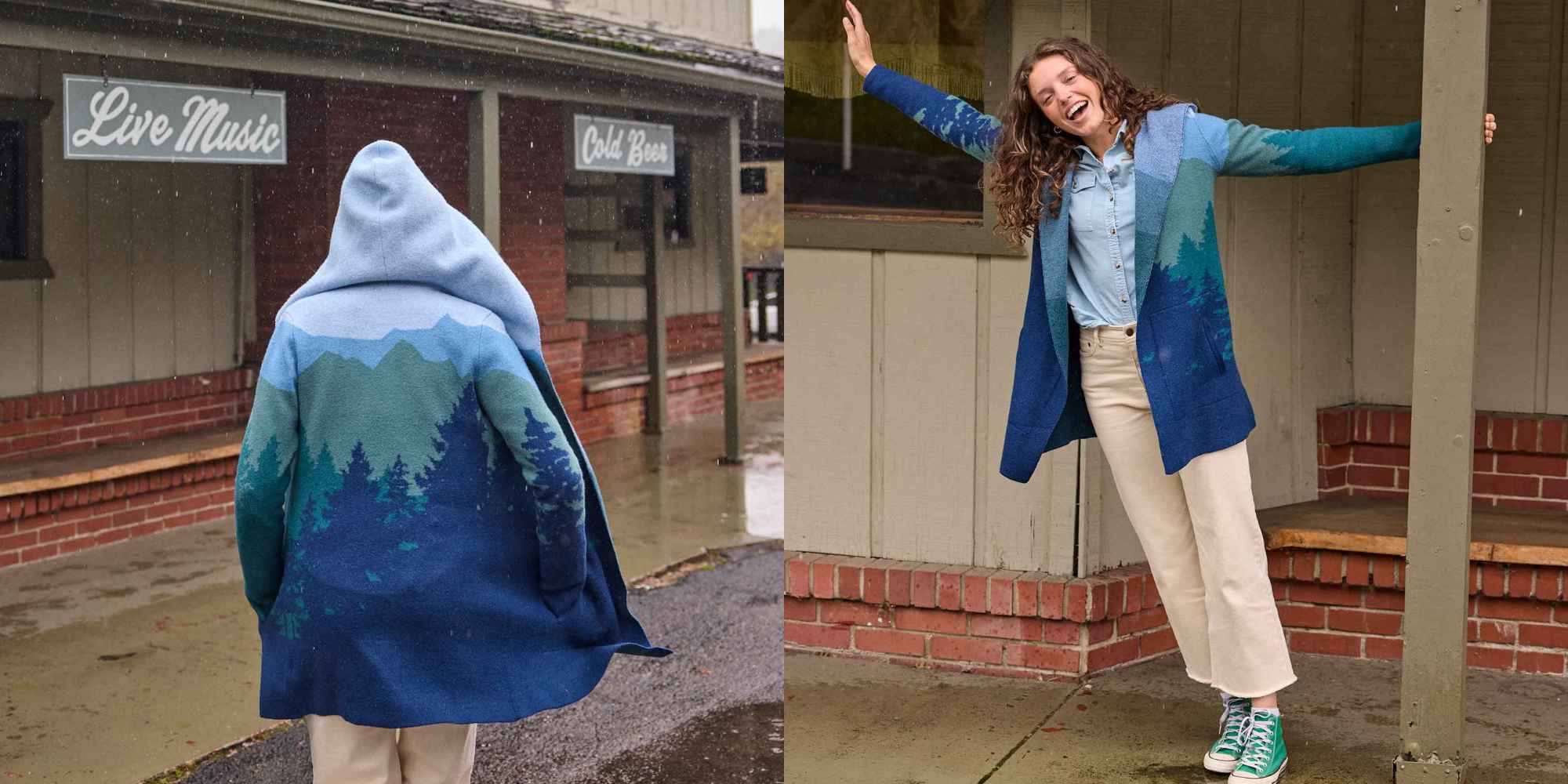
Woven with a beautiful alpine jacquard pattern, this hoodie is made from non-mulesed Merino wool and features pockets at the sides. It’s ideal as a mid-layer under a longer coat when you’re out exploring, or as a cosy item for grabbing a post-walk hot chocolate.
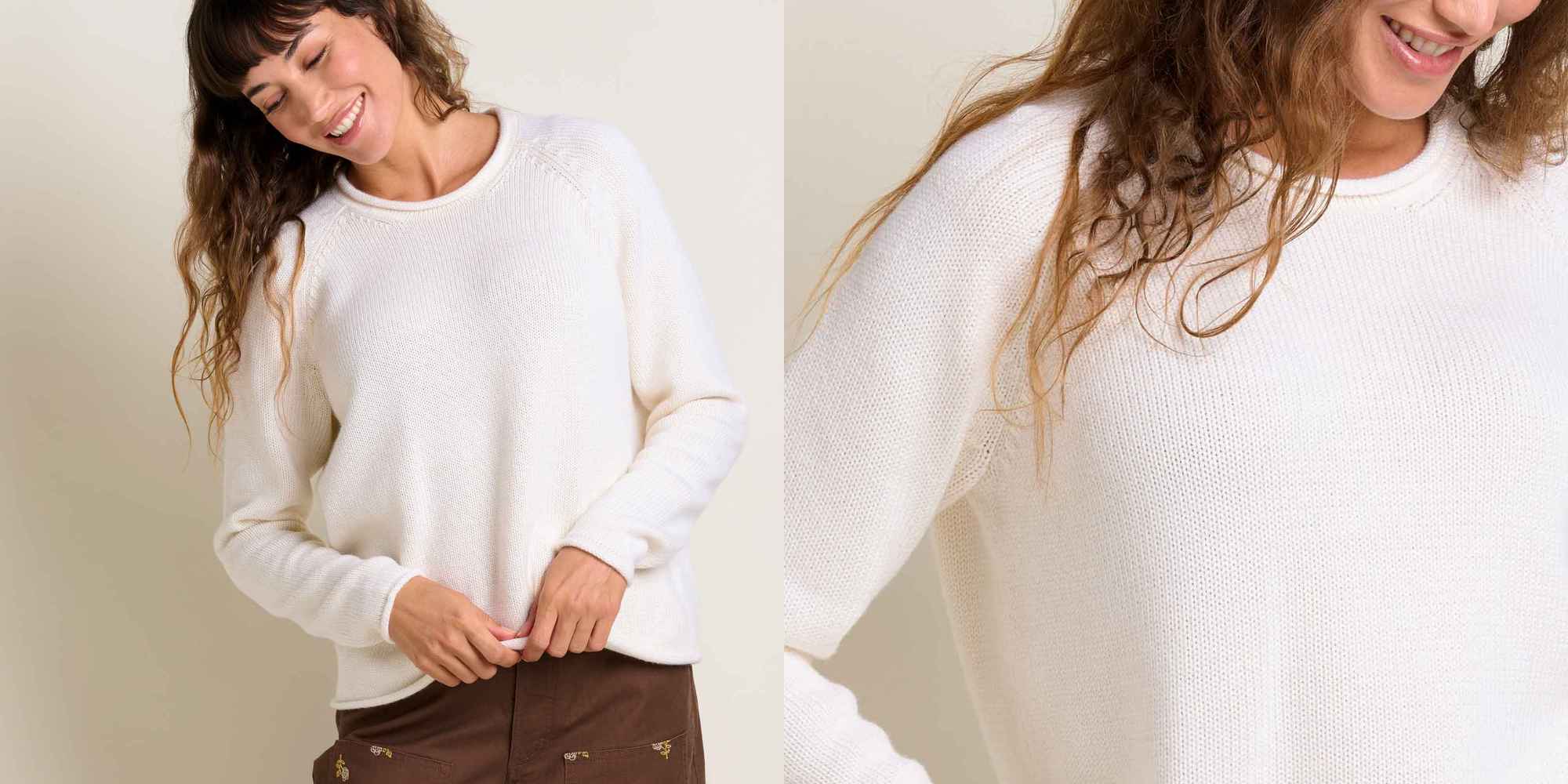
This Alpineglo sweater is a blend of 50% organic cotton and 50% non-mulesed Merino wool, so it’s going to help regulate your temperature in most climates. On top of that, the neutral tone and straight fit make it really versatile—you’ll be reaching for it on the regular.
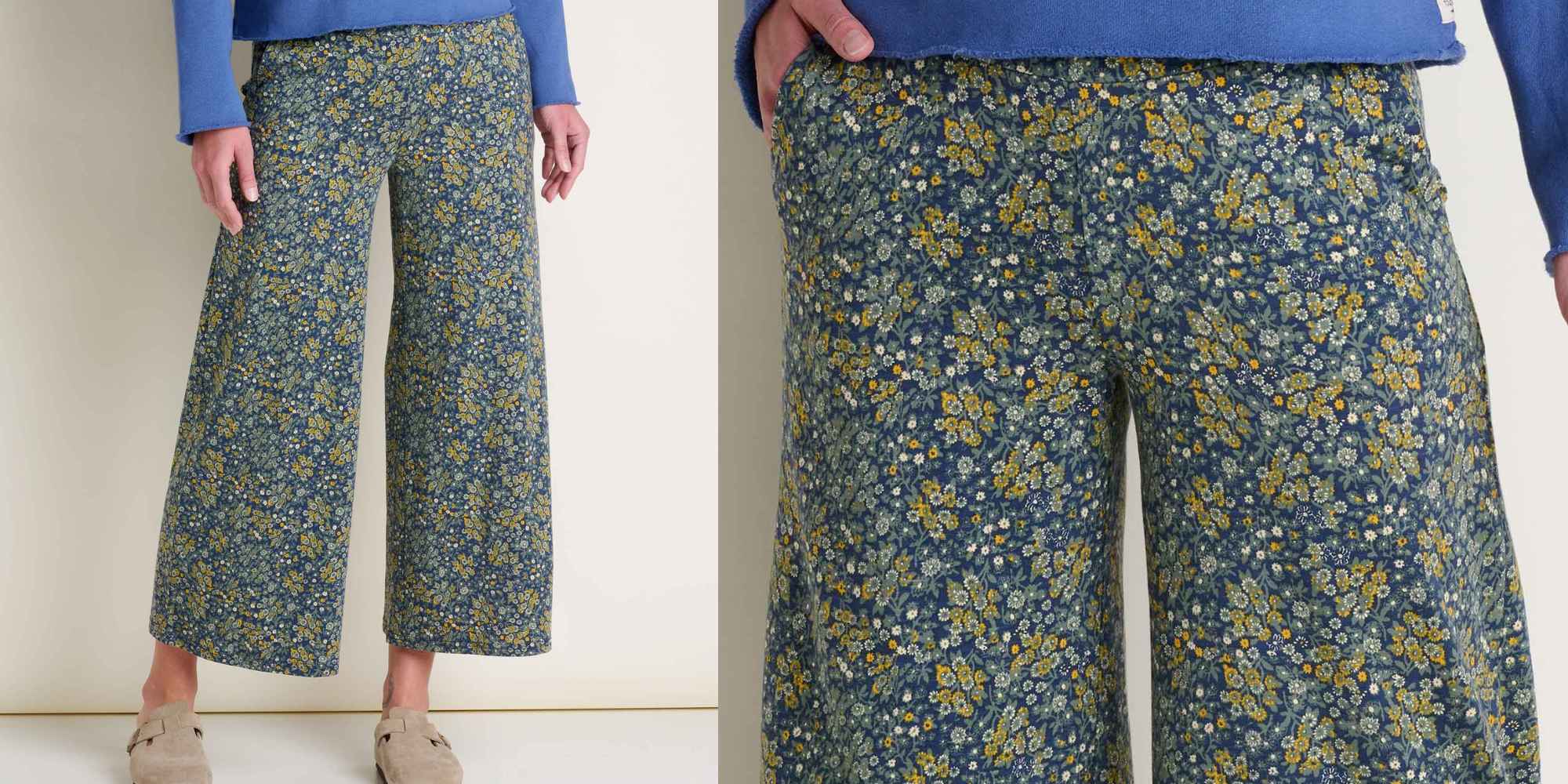
Toad&Co calls these cropped trousers “sweatpant comfortable, going-out presentable”, which makes sense, given they’re made with organic cotton and Tencel Lyocell for softness and have a comfortable wide waistband, not to mention a pretty floral pattern.
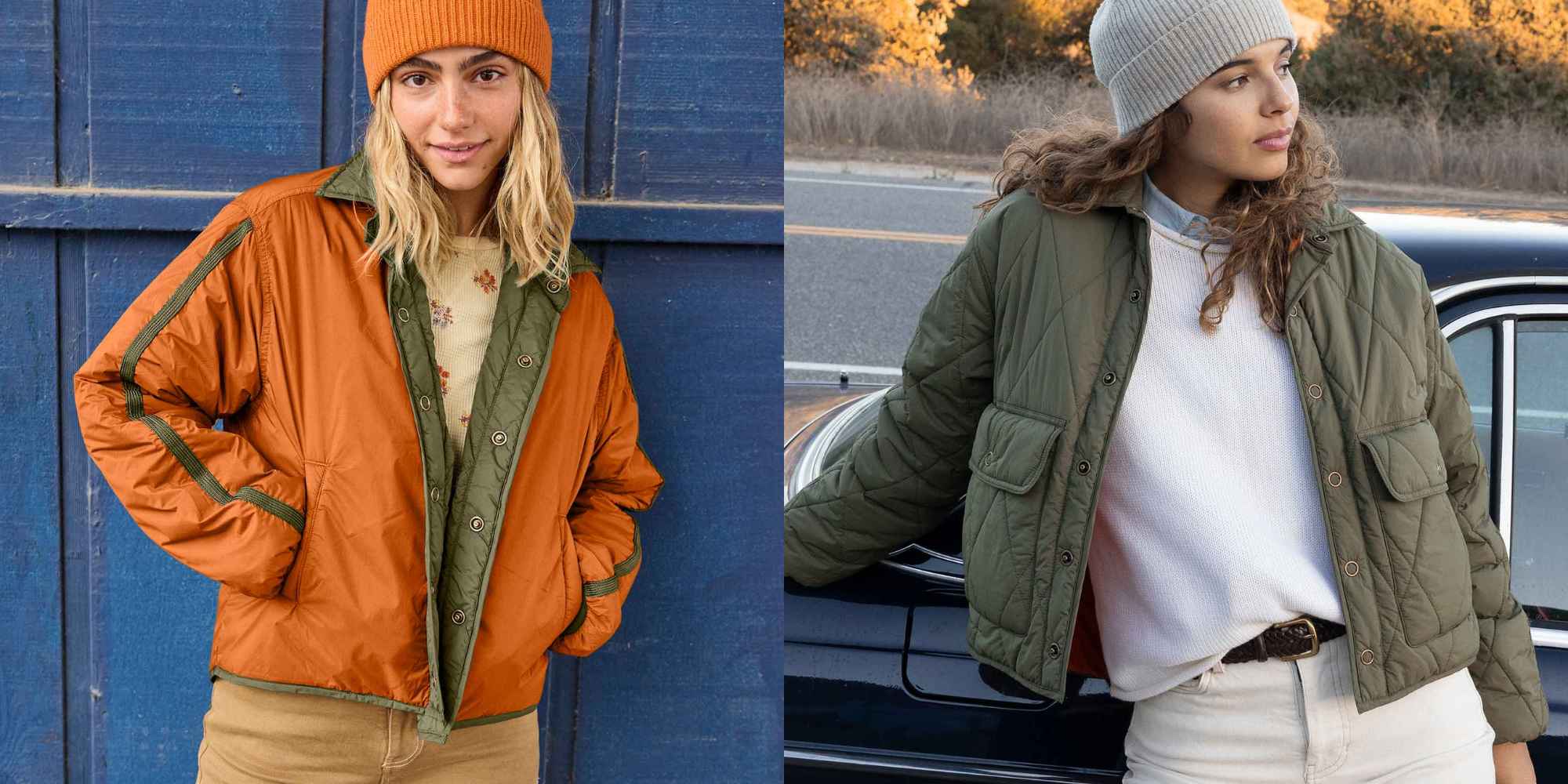
This Nomader jacket is reversible, packable, and water-resistant. In other words, it’s the ideal item to take with you for outdoor adventures. It’s made from recycled nylon and lightly quilted for warmth.
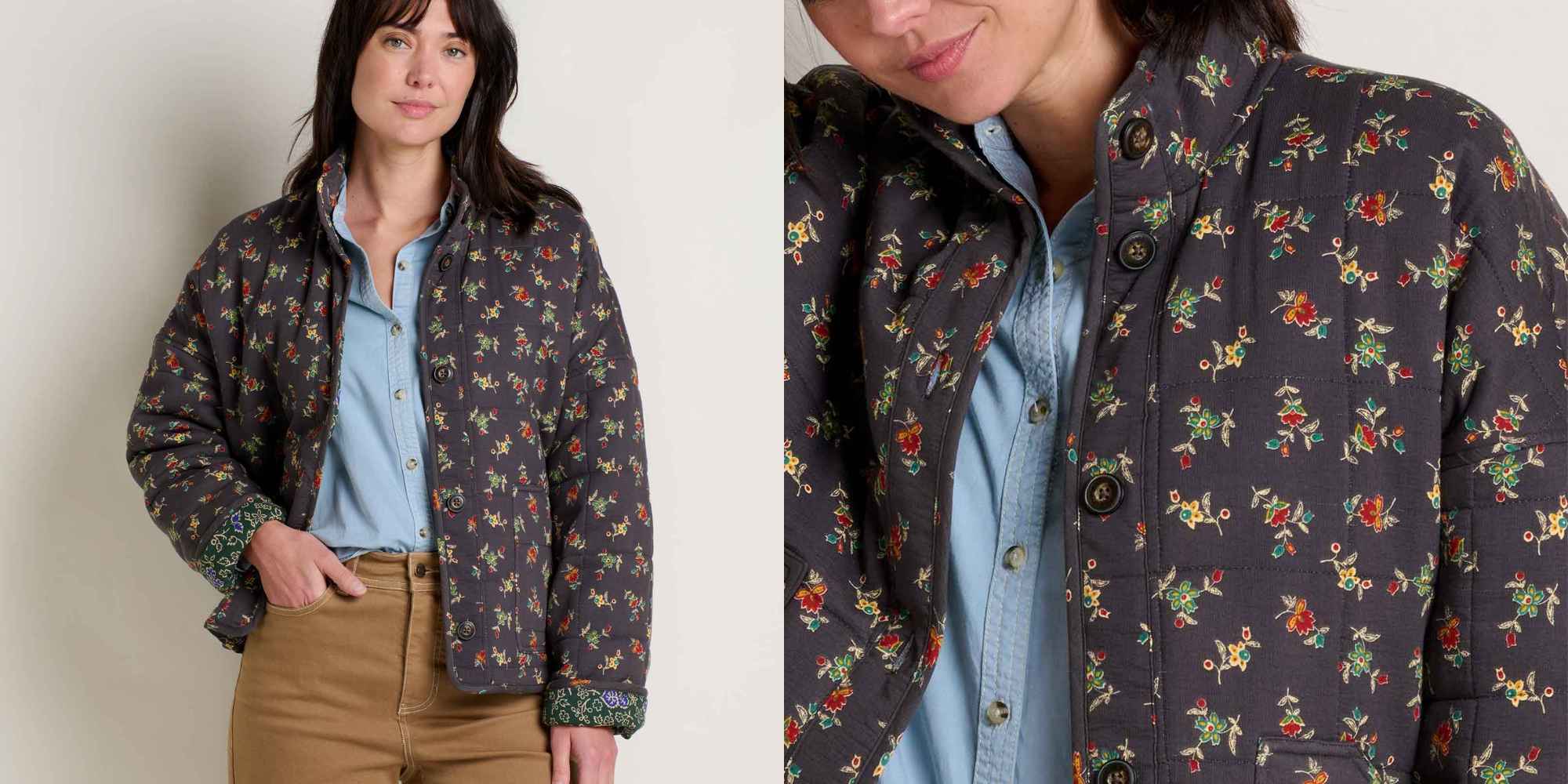
Toad&Co picked the crepe-like organic cotton for this jacket so that you could fold it away in a bag and have it still look presentable when you pull it out. It’s also packed with recycled polyester padding for extra warmth.
 Balsam Cutoff TrousersThese Balsam Trousers are made with a tiny bit of stretch and a special waistband for comfort, so they’ll flex with you and feel good all the time. The neutral brown colour also goes with so many options.
Balsam Cutoff TrousersThese Balsam Trousers are made with a tiny bit of stretch and a special waistband for comfort, so they’ll flex with you and feel good all the time. The neutral brown colour also goes with so many options.These Balsam Trousers are made with a tiny bit of stretch and a special waistband for comfort, so they’ll flex with you and feel good all the time. The neutral brown colour also goes with so many options.
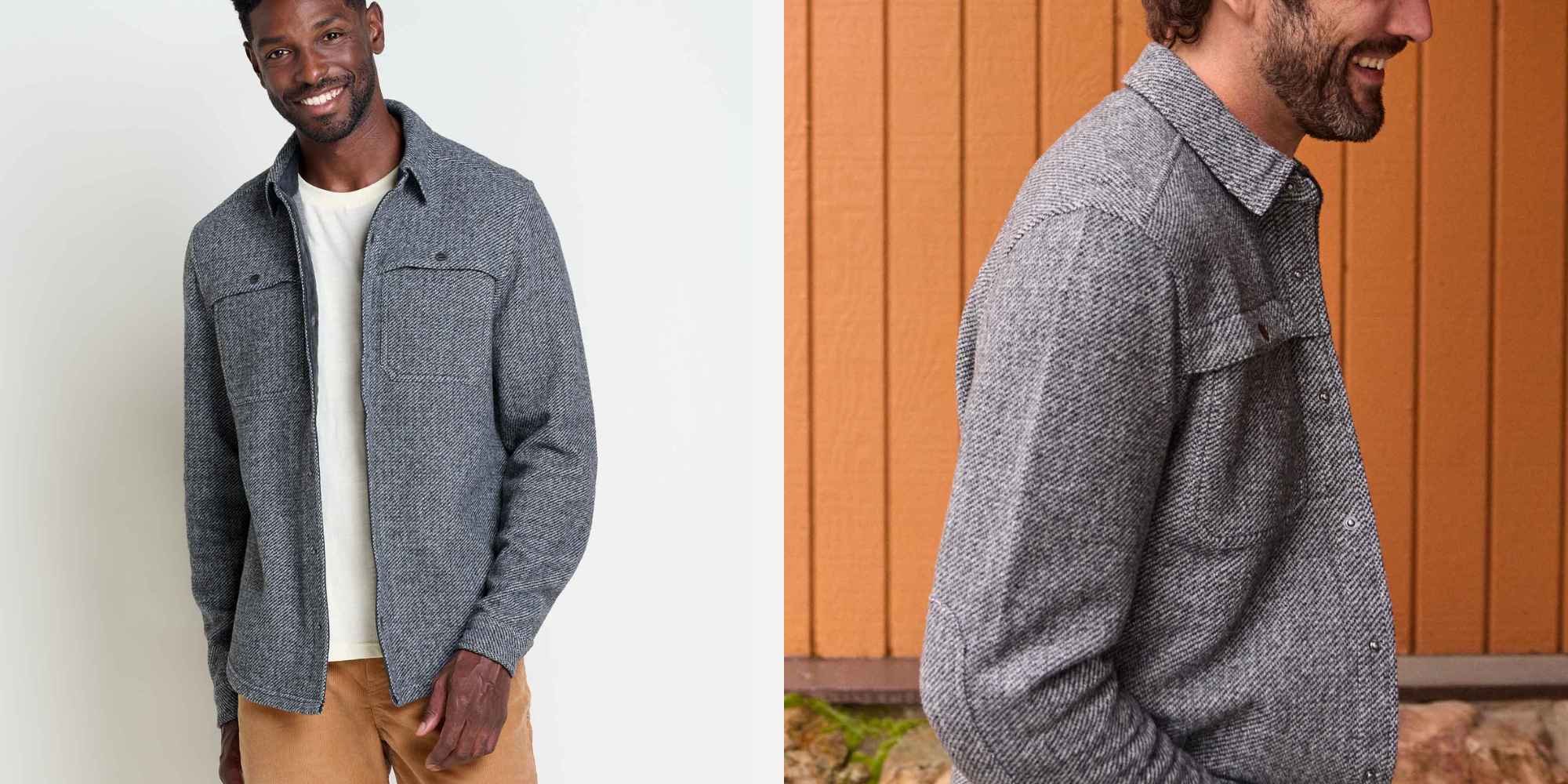
Going from a walk to dinner? From the office to drinks? This Kennicott shirt jacket fits the bill for all of the above. The smart twill fabric incorporates recycled Italian wool.

This is Toad&Co’s Re-Form Herringbone: a blend of recycled cotton and polyester that offers a soft drape and an attractive herringbone weave that looks smarter than the average checked shirt.
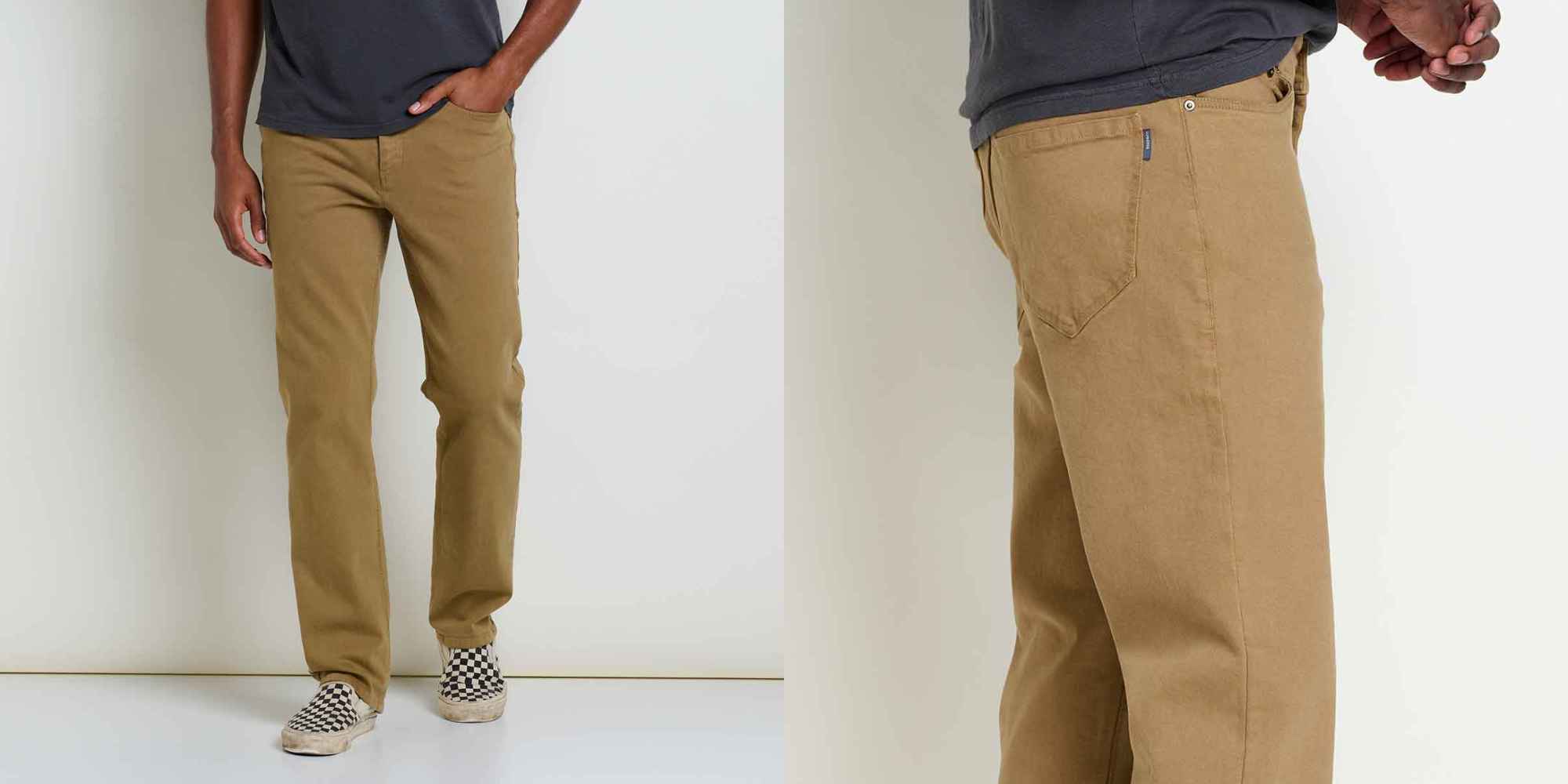
Like the women’s equivalent, these Balsam trousers have a touch of stretch and a comfortable ‘FlexForm’ waistband that mean they’re going to feel comfortable from the get-go—and you won’t need to worry about a belt, either.
Discover more of Toad&Co’s clothes.
The post How Toad&Co’s Clothes Help Everyone Enjoy the Outdoors appeared first on Good On You.
Green Living
50 DIY Christmas Presents Anyone Can Make
Last Updated on November 21, 2025
If you’re on the handmade Christmas kick this year, you’re not alone. So am I!
I’m choosing presence over presents this year and bringing back the 90s Christmas I loved as a kid – simple, crafty, low pressure, and full of small moments that feel meaningful.

If you want to gift thoughtfully, and without breaking the bank, these DIY Christmas presents are for you. There’s something for everyone on this list – whether you prefer easy or complex DIYs.
I’ve included all kinds of DIYs – beauty, cooking, fashion, and practical gifts alike. Best of all? Many of these tutorials are zero waste (or close to it).
what are good homemade Christmas gifts?
Good homemade Christmas gifts include consumable items, like homemade nut butters, vanilla extract, or jams. But not all homemade gifts are edible – you can also make items like bath bombs, candles, body scrubs, beeswax wraps, and so much more.
If you’re extra crafty, you could even make wooden gifts (like shelving or tablet holders), ceramic items (like mugs or jewelry), or knitted/crocheted pieces (like blankets, scarves or hats).
It all depends on your level of skill, time at your disposal, and ingredients/materials you have access to.

what are good inexpensive Christmas gifts?
Some good inexpensive Christmas gifts are DIY cornstarch ornaments, handmade body or lip scrub, seasoned salt blends, and homemade treats (like these chocolate chip cookies or vegan sugar cookies).
And never forget to hit up your local thrift store – you can find so many great items that would make affordable gift baskets!
Wrapping DIY Christmas gifts also doesn’t have to be expensive. Reusing gift bags and ribbons from last year, upcycling packaging paper, or even repurposing a scarf for furoshiki wrap are all low-waste and affordable!
RELATED: Gift Wrapping: How to Keep It Easy, Eco and Chic
how can I make a last minute gift?
You can make a last minute gift by getting crafty using the materials you have on hand!
For example, if you have a cardboard box, why not try making an upcycled cardboard dollhouse, vehicle, or pirate ship for a child? For adults, a DIY storage container or a shoe rack works.
One of my fav last minute gifts is scented bath salts in an upcycled glass jar – just a little Epsom salt and essential oil blends will do the trick!
Here’s my list of DIY Christmas gifts – something for everyone and every skill level.

- Bath salts
- DIY makeup like mascara/eyeliner, or lip to cheek
- Bath bombs
- Lip scrub
- Lip balm
- Face mask
- Body lotion
- Natural perfume
- Dry shampoo
- Shampoo bar
- Body soap
- Deodorant
- Rose water toner
- Hand-poured coconut/soy/beeswax candles
- Simmer pot in a jar
- Cookie, brownie, soup mix or hot cocoa mix in a jar
- Handmade seasoning blends
- Vanilla extract
- Vegan caramels or plant-based butter wrapped in compostable parchment paper
- Herb or citrus infused olive oil
- Peanut butter + jam
- Beeswax wraps
- Apple or pumpkin butter
- Sourdough or no-knead artisan bread
- Finished embroidery hoops
- Embroidered pillows, tote bags, clothes or cloth napkins
- Sewn cotton rounds
- Knitted scarf, hat, gloves, sweater, or blanket
- Hand warmers
- Quilt blanet, quilted coat or quilted wallet
- Tie dyed secondhand silk scarves, clothing or sheets
- Hand painted or drawn artwork
- Air dry clay paint palette
- DIY wooden frame for paintings or print photos
- Handmade ceramics (mugs, chawan, chasen holder, vase, spoon rest, etc.)
- Woodworked items (birdhouse, shelving, bookcase, wall guitar mount)
- Carving wooden bowls by hand
- Natural branch coasters
- Plant propagations in one of these DIY planters
- Seed balls using native seeds
- Handwoven baskets or bowls
- Macrame produce bag
- Macrame plant hanger
- Fabric paper mache bowls
- Upcycled paper earring jewelry
- Clay earrings
- Handmade plush toys
- Felt ‘food’ toys
- Wooden toys (like vehicles, blocks, or dollhouses)
- Knit or crocheted baby clothes
What do you think of these DIY Christmas presents? Let me know in the comments!
The post 50 DIY Christmas Presents Anyone Can Make appeared first on Going Zero Waste.
Green Living
8 Best Non Toxic Rugs For a Sustainable Home
Last Updated on November 6, 2025
Did you know most rugs are made from polyester, aka plastic? Arguably, a good chunk of our furniture and home decor is nowadays.
And lets not forget – rugs can get a lot of foot traffic. If it’s made from polyester, chances are those plastic fibers are going to shed and get onto us. Or worse, in us.

Some of the links in this post are affiliate links; for more information please see my disclosure policy.
Microplastics have been found in human feces, blood, and even placentas. And according to a study from Stanford University, those who had microplastics in their plaque had a higher risk of heart attack, stroke and death than those who didn’t.
On top of this, 5 billion pounds of rugs go to waste each year – that’s 2% of total US landfill. And if they’re made from plastic? They won’t biodegrade.
It’s more important than ever to reduce our exposure to microfibers where we can. Which is why I’ve rounded up the best non toxic rugs on the market.
what is the least toxic rug?
The least toxic rug will have sustainable materials and use no harsh chemicals (like PFAs) in their production.
Here’s what to look for when purchasing a non-toxic rug:
- Sustainable materials, such as organic cotton, jute, sisal or wool
- Low-waste packaging + delivery
- Natural, non-synthetic dyes
- Third-party certifications like OEKO-TEK, Fair Trade, GOTs
- Easy to spot-clean or machine wash
- Available in various styles, patterns + colors to suit your needs
do all rugs have PFAS?
According to Department of Toxic Substances Control (DTSC), only four samples of 201 carpets and rugs were found to contain more than 100 parts per million in their fibers, indicating PFAS were intentionally added to the products.
However, while PFAs may not be a huge concern for rugs, microplastic pollution is, specifically if your carpet is synthetic. Your best bet is to check the material your rug is made from and choose natural fibers whenever possible.
what is the best non-toxic rug for nursery?
The best non-toxic rug for a nursery would be made from natural materials like wool and organic cotton (which are soft on baby’s skin).
I recommend also checking for natural latex for the rug backing and underlay pads. Brands on this list that offer kid-friendly sizes and patterns include Lorena Canals, Nestig, Quince, and Loomy (more on each below).
what brand of rugs are non-toxic?
The brands of rugs that are non-toxic are listed below. I’ve gone ahead and highlighted some of my favorite features of each brand, but it isn’t an exhaustive list. Be sure to check out their websites for more information.

1. hook and loom
- Various rug sizes, shapes + patterns
- Made from GOTs certified organic cotton, recycled cotton + wool
- No dyes or harmful chemicals
- No latex
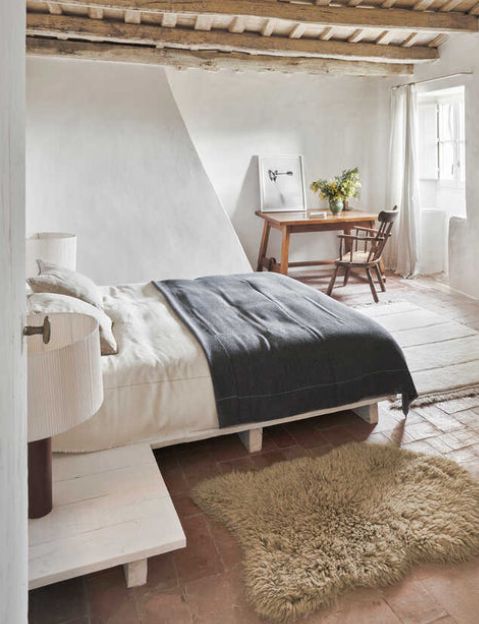
2. lorena canals
- Various rug sizes, shapes + patterns
- Handmade by artisans using recycled materials like organic cotton + wool
- Nontoxic dyes
- Make your own option
- Machine washable
- Rugcycled line made from recycled materials in their own factory

3. sabai
- Field rug
- Woven using wool + jute
- Available in 3 varying sizes
- Rug pad add-on available for reduced movement
- Certified B Corporation

4. quince
- Various sizes + patterns, best known for vintage-inspired looks
- Made from natural materials like wool, jute, + cotton
- Handcrafted by artisans in India
- Transparent pricing practices
- Compostable poly bags + recycled plastic mailers

5. west elm
- Rugs for every area of the home, in varying sizes
- Made from wool, jute, hemp, cotton, TENCEL + recycled materials
- Handspun by skilled artisans in India
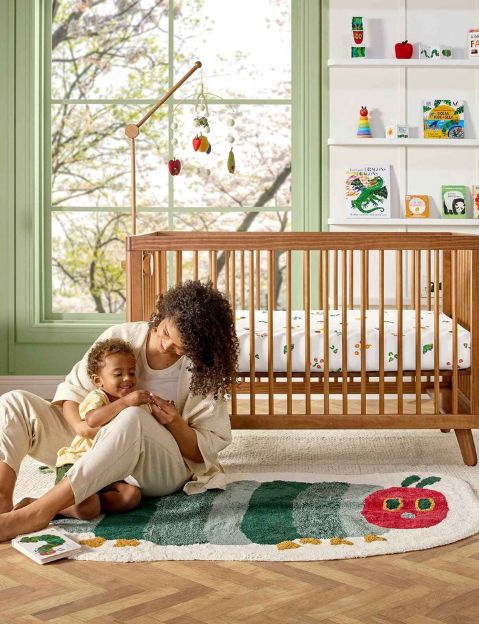
6. nestig
- Area + washable rugs made with fun shapes/designs for babies + kids
- Washable rugs made with organic cotton + nontoxic dyes
- Area rugs made with cotton + each colored element crafted from recycled cotton
- Handmade in Brazil

7. cold picnic
- Various rug shapes + sizes, abstract patterns + bold colors
- Made with wool, bamboo silk, cotton, hemp, + deadstock materials
- Designed in a Brooklyn studio, handmade by artisans in India
- Committed to reducing packaging waste where possible
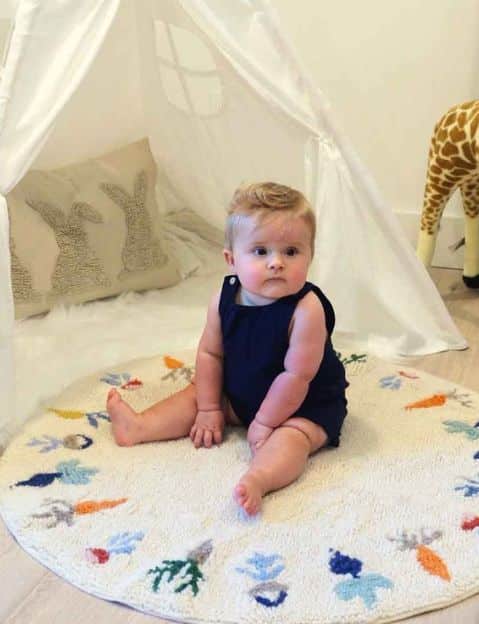
8. loomy
- Various rug sizes, shapes + patterns
- Made from banana silk, hemp, jute, recycled fiber, viscose, or wool
- Any colored yarn dyed using low-impact techniques
- Handcrafted by indigenous artisans
So what do you think of these non toxic, sustainable rugs? Let me know in the comments!
The post 8 Best Non Toxic Rugs For a Sustainable Home appeared first on Going Zero Waste.
-
Climate Change4 months ago
Guest post: Why China is still building new coal – and when it might stop
-
Greenhouse Gases4 months ago
Guest post: Why China is still building new coal – and when it might stop
-
Climate Change2 years ago
Spanish-language misinformation on renewable energy spreads online, report shows
-

 Greenhouse Gases2 years ago
Greenhouse Gases2 years ago嘉宾来稿:满足中国增长的用电需求 光伏加储能“比新建煤电更实惠”
-
Climate Change Videos2 years ago
The toxic gas flares fuelling Nigeria’s climate change – BBC News
-

 Climate Change2 years ago
Climate Change2 years ago嘉宾来稿:满足中国增长的用电需求 光伏加储能“比新建煤电更实惠”
-

 Carbon Footprint2 years ago
Carbon Footprint2 years agoUS SEC’s Climate Disclosure Rules Spur Renewed Interest in Carbon Credits
-
Climate Change2 years ago
Why airlines are perfect targets for anti-greenwashing legal action



